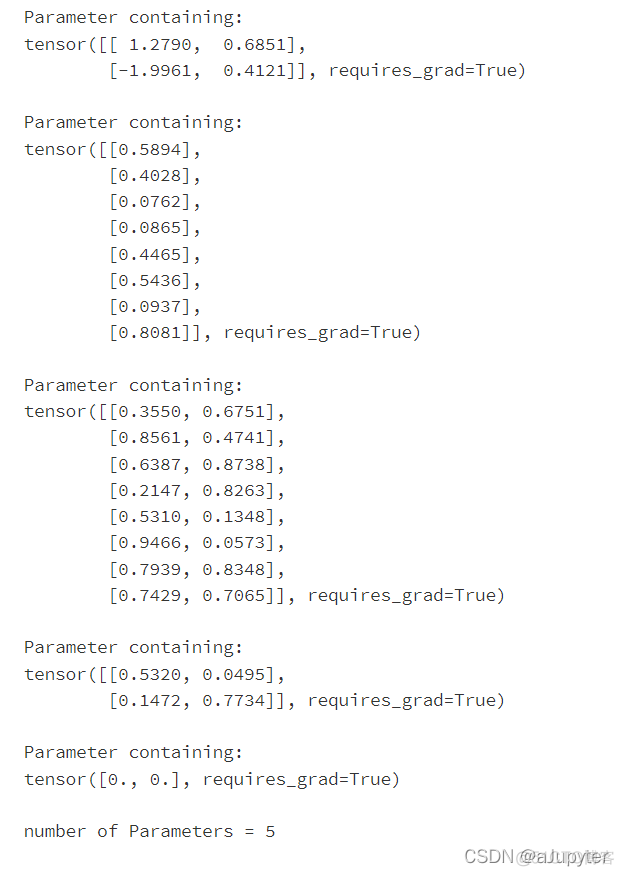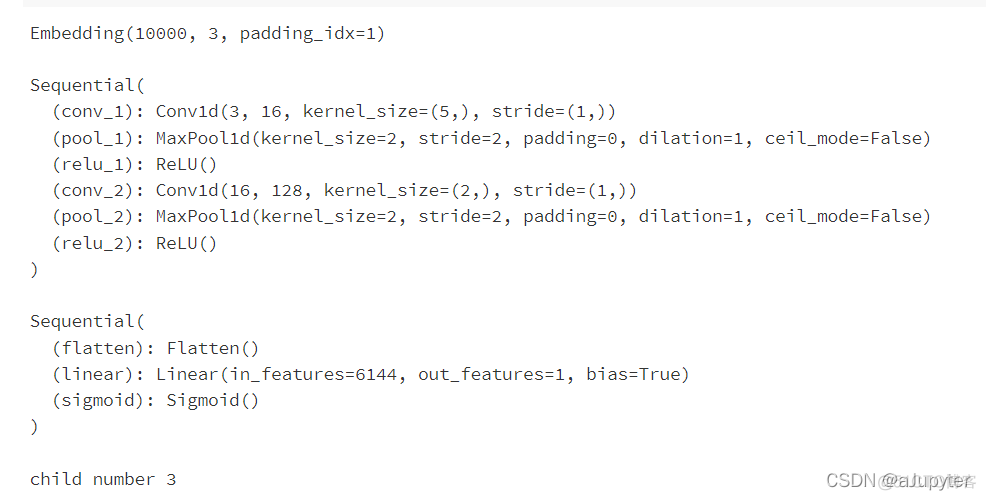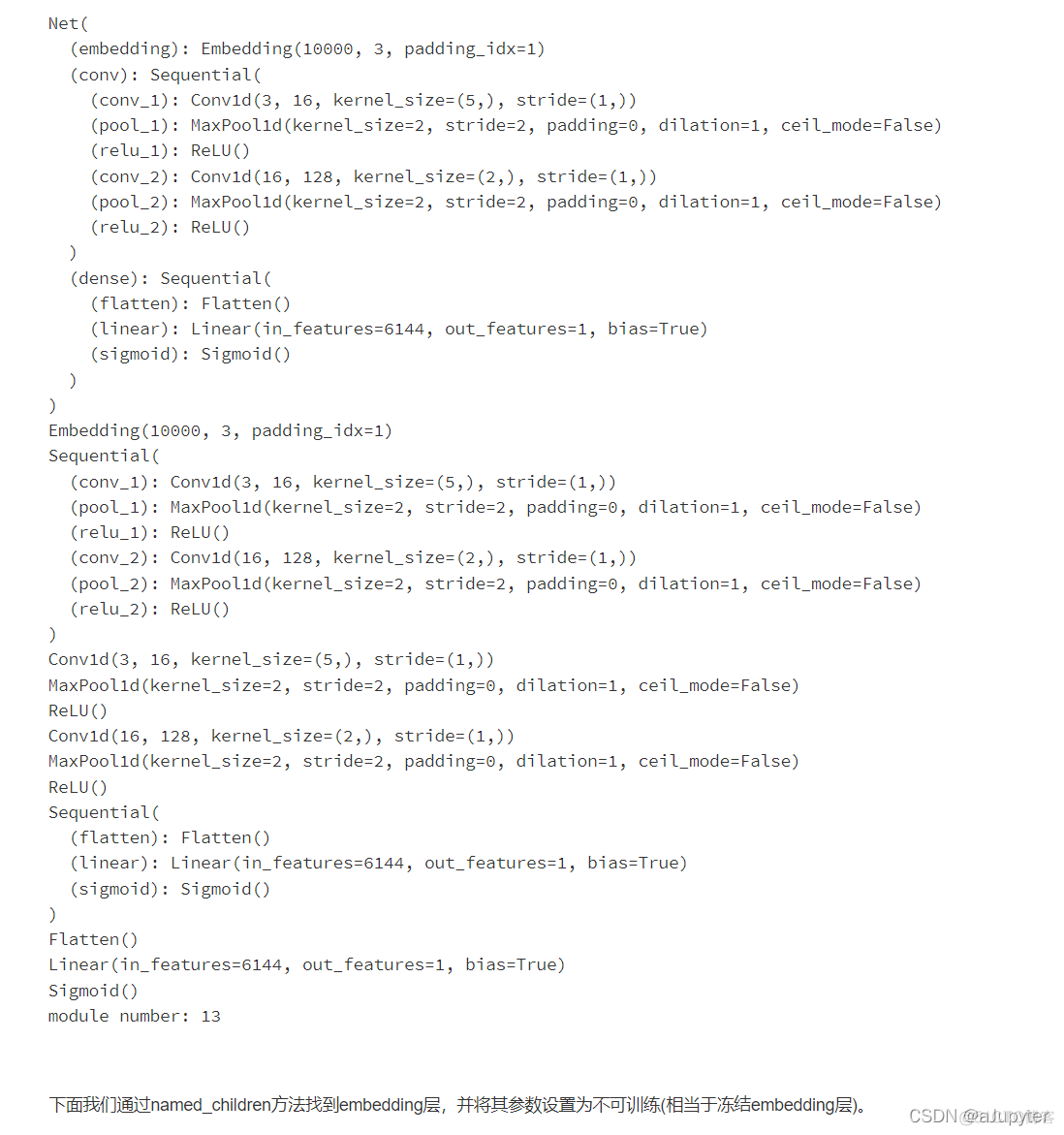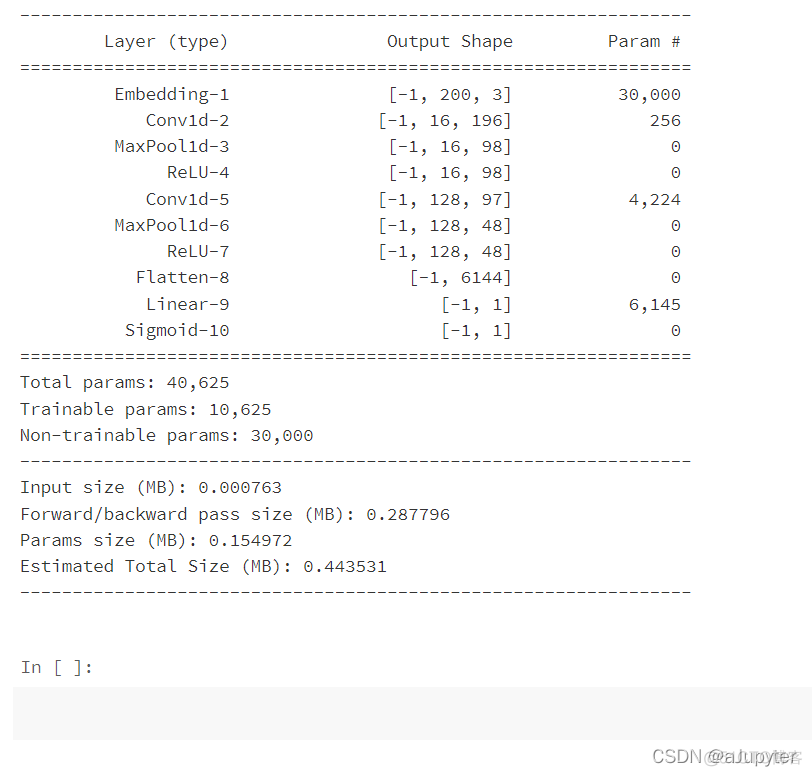系统教程20天拿下Pytorch 最近和中哥、会哥进行一个小打卡活动,20天pytorch,这是第13天。欢迎一键三连。 后面可能会考虑加速,开学前刷完。
文章目录
- 一、nn.functional 和 nn.Module
- 二、使用nn.Module来管理参数
- 三、使用nn.Module来管理子模块
- 总结
import datetime
#打印时间
def printbar():
nowtime = datetime.datetime.now().strftime('%Y-%m-%d %H:%M:%S')
print("\n"+"=========="*8 + "%s"%nowtime)
#mac系统上pytorch和matplotlib在jupyter中同时跑需要更改环境变量
os.environ["KMP_DUPLICATE_LIB_OK"]="TRUE"
一、nn.functional 和 nn.Module
前面我们介绍了Pytorch的张量的结构操作和数学运算中的一些常用API。
利用这些张量的API我们可以构建出神经网络相关的组件(如激活函数,模型层,损失函数)。
Pytorch和神经网络相关的功能组件大多都封装在 torch.nn模块下。
这些功能组件的绝大部分既有函数形式实现,也有类形式实现。
其中nn.functional(一般引入后改名为F)有各种功能组件的函数实现。例如:
(激活函数)
F.relu
F.sigmoid
F.tanh
F.softmax
(模型层)
F.linear
F.conv2d
F.max_pool2d
F.dropout2d
F.embedding
(损失函数)
F.binary_cross_entropy
F.mse_loss
F.cross_entropy
为了便于对参数进行管理,一般通过继承 nn.Module 转换成为类的实现形式,并直接封装在 nn 模块下。
例如:
(激活函数)
nn.ReLU
nn.Sigmoid
nn.Tanh
nn.Softmax
(模型层)
nn.Linear
nn.Conv2d
nn.MaxPool2d
nn.Dropout2d
nn.Embedding
(损失函数)
nn.BCELoss
nn.MSELoss
nn.CrossEntropyLoss
实际上nn.Module除了可以管理其引用的各种参数,还可以管理其引用的子模块,功能十分强大。
二、使用nn.Module来管理参数
在Pytorch中,模型的参数是需要被优化器训练的,因此,通常要设置参数为 requires_grad = True 的张量。
同时,在一个模型中,往往有许多的参数,要手动管理这些参数并不是一件容易的事情。
Pytorch一般将参数用nn.Parameter来表示,并且用nn.Module来管理其结构下的所有参数。
import torchfrom torch import nn
import torch.nn.functional as F
from matplotlib import pyplot as plt# nn.Parameter 具有 requires_grad = True 属性
w = nn.Parameter(torch.randn(2,2))
print(w)
print(w.requires_grad)

params_list = nn.ParameterList([nn.Parameter(torch.rand(8,i)) for i in range(1,3)])
print(params_list)
print(params_list[0].requires_grad)

params_dict = nn.ParameterDict({"a":nn.Parameter(torch.rand(2,2)),
"b":nn.Parameter(torch.zeros(2))})
print(params_dict)
print(params_dict["a"].requires_grad)

# module.parameters()返回一个生成器,包括其结构下的所有parameters
module = nn.Module()
module.w = w
module.params_list = params_list
module.params_dict = params_dict
num_param = 0
for param in module.parameters():
print(param,"\n")
num_param = num_param + 1
print("number of Parameters =",num_param)

#以下范例为Pytorch中nn.Linear的源码的简化版本
#可以看到它将需要学习的参数放在了__init__构造函数中,并在forward中调用F.linear函数来实现计算逻辑。
class Linear(nn.Module):
__constants__ = ['in_features', 'out_features']
def __init__(self, in_features, out_features, bias=True):
super(Linear, self).__init__()
self.in_features = in_features
self.out_features = out_features
self.weight = nn.Parameter(torch.Tensor(out_features, in_features))
if bias:
self.bias = nn.Parameter(torch.Tensor(out_features))
else:
self.register_parameter('bias', None)
def forward(self, input):
return F.linear(input, self.weight, self.bias)
三、使用nn.Module来管理子模块
一般情况下,我们都很少直接使用 nn.Parameter来定义参数构建模型,而是通过一些拼装一些常用的模型层来构造模型。
这些模型层也是继承自nn.Module的对象,本身也包括参数,属于我们要定义的模块的子模块。
nn.Module提供了一些方法可以管理这些子模块。
children() 方法: 返回生成器,包括模块下的所有子模块。
named_children()方法:返回一个生成器,包括模块下的所有子模块,以及它们的名字。
modules()方法:返回一个生成器,包括模块下的所有各个层级的模块,包括模块本身。
named_modules()方法:返回一个生成器,包括模块下的所有各个层级的模块以及它们的名字,包括模块本身。
其中chidren()方法和named_children()方法较多使用。
modules()方法和named_modules()方法较少使用,其功能可以通过多个named_children()的嵌套使用实现。
class Net(nn.Module):def __init__(self):
super(Net, self).__init__()
self.embedding = nn.Embedding(num_embeddings = 10000,embedding_dim = 3,padding_idx = 1)
self.conv = nn.Sequential()
self.conv.add_module("conv_1",nn.Conv1d(in_channels = 3,out_channels = 16,kernel_size = 5))
self.conv.add_module("pool_1",nn.MaxPool1d(kernel_size = 2))
self.conv.add_module("relu_1",nn.ReLU())
self.conv.add_module("conv_2",nn.Conv1d(in_channels = 16,out_channels = 128,kernel_size = 2))
self.conv.add_module("pool_2",nn.MaxPool1d(kernel_size = 2))
self.conv.add_module("relu_2",nn.ReLU())
self.dense = nn.Sequential()
self.dense.add_module("flatten",nn.Flatten())
self.dense.add_module("linear",nn.Linear(6144,1))
self.dense.add_module("sigmoid",nn.Sigmoid())
def forward(self,x):
x = self.embedding(x).transpose(1,2)
x = self.conv(x)
y = self.dense(x)
return y
net = Net()i = 0
for child in net.children():
i+=1
print(child,"\n")
print("child number",i)

for name,child in net.named_children():
i+=1
print(name,":",child,"\n")
print("child number",i)

for module in net.modules():
i+=1
print(module)
print("module number:",i)

下面我们通过named_children方法找到embedding层,并将其参数设置为不可训练(相当于冻结embedding层)。
print(children_dict)
embedding = children_dict["embedding"]
embedding.requires_grad_(False) #冻结其参数

for param in embedding.parameters():
print(param.requires_grad)
print(param.numel())

summary(net,input_shape = (200,),input_dtype = torch.LongTensor)
# 不可训练参数数量增加

总结
nn.Parameter 具有 requires_grad = True 属性
nn.ParameterList 可以将多个nn.Parameter组成一个列表
nn.ParameterDict 可以将多个nn.Parameter组成一个字典
可以用Module将它们管理起来 module.parameters()返回一个生成器,包括其结构下的所有parameters
nn.Module提供了一些方法可以管理这些子模块。
children() 方法: 返回生成器,包括模块下的所有子模块。
named_children()方法:返回一个生成器,包括模块下的所有子模块,以及它们的名字。
modules()方法:返回一个生成器,包括模块下的所有各个层级的模块,包括模块本身。
named_modules()方法:返回一个生成器,包括模块下的所有各个层级的模块以及它们的名字,包括模块本身。
其中chidren()方法和named_children()方法较多使用。
modules()方法和named_modules()方法较少使用,其功能可以通过多个named_children()的嵌套使用实现。
**模型层冻结:**找到相应的层,让其requires_grad参数为False即可,如下
embedding.requires_grad_(False)
